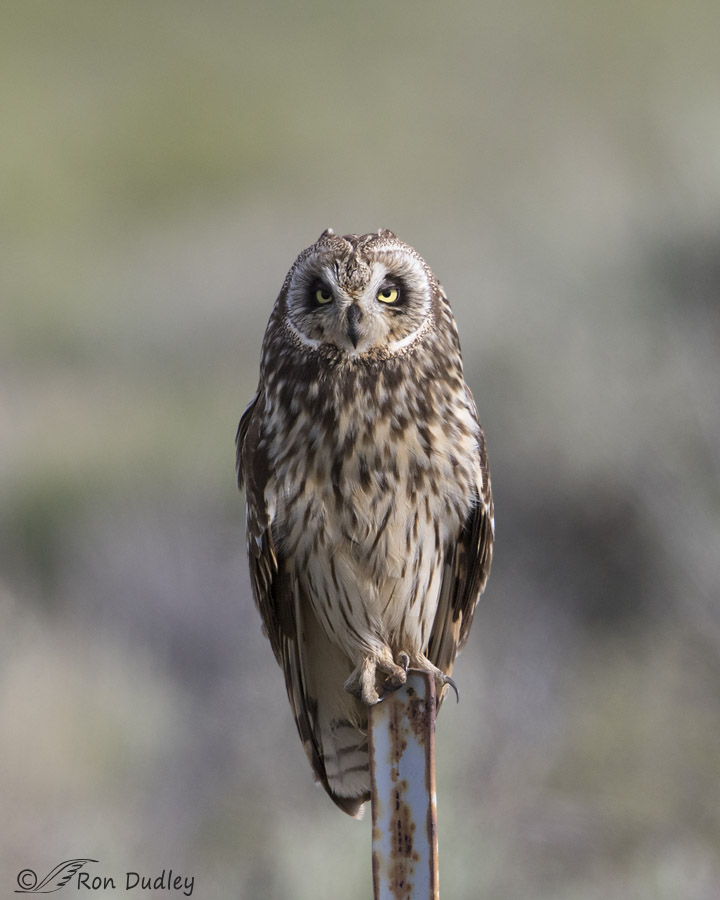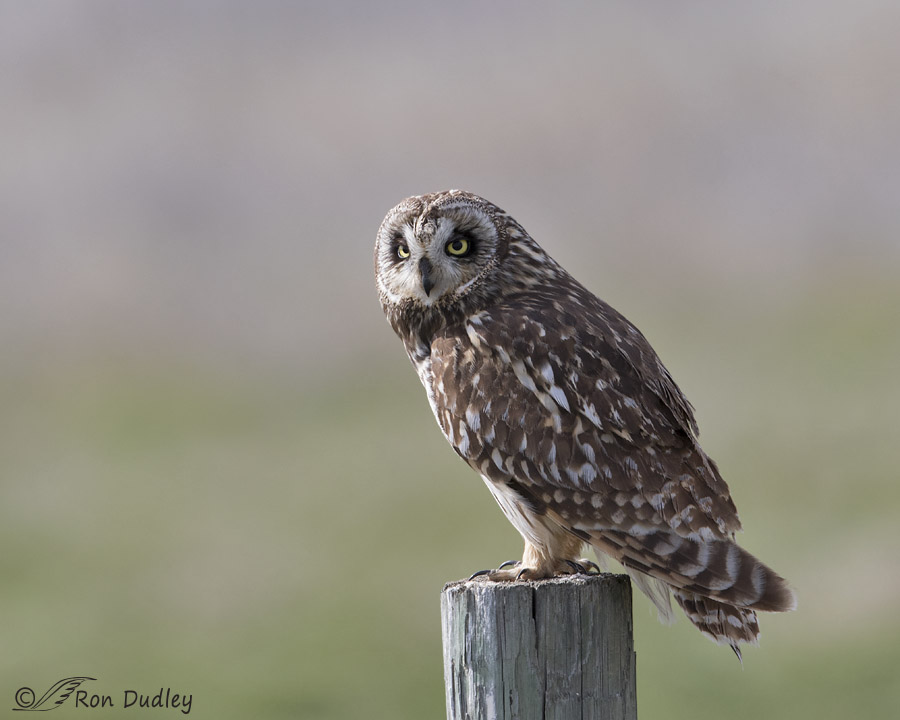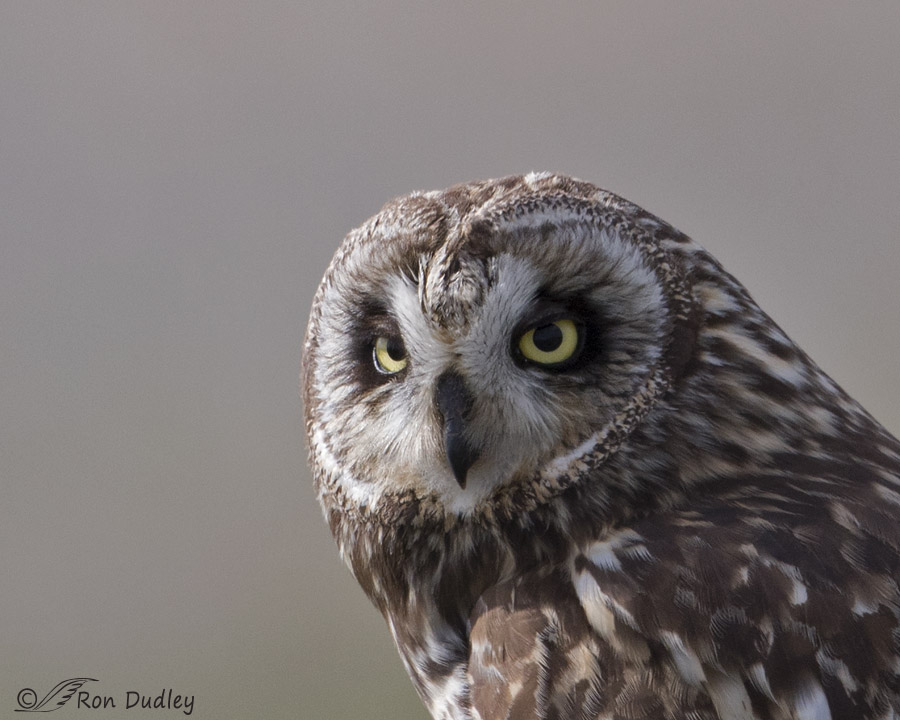Short-eared Owls are in serious decline throughout their range and their species status in many states is uncertain. My experience in the field backs that up – where I used to see them regularly I no longer do. Though it’s only anecdotal evidence I’d estimate that my sightings of the species have dropped by something like 75% in the last few years. And I specifically look for them in their preferred habitat.
 1/3200, f/6.3, ISO 800, Canon 7D Mark II, Canon EF500mm f/4L IS II USM +1.4 tc, not baited, set up or called in
1/3200, f/6.3, ISO 800, Canon 7D Mark II, Canon EF500mm f/4L IS II USM +1.4 tc, not baited, set up or called in
But yesterday morning I encountered a cluster of them in a relatively remote area of Tooele County. There were at least four owls (and possibly one or two more) perching on fence posts along the road and hunting low over marshland in their typical manner. This bird is one of them.

1/1250, f/6.3, ISO 640, Canon 7D Mark II, Canon EF500mm f/4L IS II USM +1.4 tc, not baited, set up or called in
I was never able to get a good light angle on any of the owls but while I was watching this one through my lens I noticed something slightly odd about its right eye. When I first saw this image on my computer I thought it might simply be the play of light on the bulge of the cornea but…

a huge crop of the same image suggests to me that part of the lower eyelid may be pulled away from the surface of the eye. Whether or not it’s an anomaly is beyond my diagnostic abilities. I just don’t know enough about owl eyes to even hazard a guess but it did arouse my curiosity.
I was delighted almost to the point of giddiness to see this many Short-eared Owls concentrated in a small area. Because of their concern for the species HawkWatch International has recently announced a new citizen science project whose focus is monitoring Short-eared Owls in Utah and they’ve asked for input on sightings. Yesterday afternoon I reported this sighting to HWI.
Hopefully their efforts and those of others will eventually result in a comeback for the species.
Ron


Great discovery and sensational shots Ron! Let’s hope the species will make a comeback.
Charlotte
I love that your emotional giddiness had no impact on your shutter finger or your curiosity. I hope there is a resurgence, hope it continues and spreads faster than ebola, and like Patty and you, suspect that our actions might have something to do with the decline in numbers. Sigh. And hiss and spit. We really are a species of slow learners.
We have and are causing a lot of mayhem with birds, haven’t we, EC? It surely doesn’t speak well of us as a species.
Hi! great photo’s! I dearly love all Owls! Have a great day!
Thank you, Hummingbird Lover.
Last night we saw an interesting PBS , heart breaking, program on sage, mankind’s assault on sage, and the challenges gaced by the sage grouse…including the activity on a lek.. I hadn’t realized that sage grouse actually EAT sage…that was new to me…
Yep, that’s pretty much all they eat as adults, Patty. When they say Sage Grouse are sage-dependent, they mean it. And other species are too, Sage Thrasher for example.
Many of us also watched that PBS program. For me it was almost like going home because I spend so much time in that habitat.
Ron – We do see owls with conjunctivitis but typically the inner edges of the lids are red and they can be a bit swollen; it usually responds well to antibiotic ophthalmic ointment. The lid in this photo doesn’t strike me as a problem but of course without the bird in the hand and the ability to compare it with the other eye I can’t be 100% sure. But I wouldn’t worry about it unless you saw him holding the eye closed or keeping the nictitans all or part way across. Of course, they do sometimes run into thorns or pointy sticks when they dive into cover, or a tussle with a prey item may kick up dust into the eye – this is why you’ll see them close the nictitating membrane as they go to grab something. We’ve seen sticks thrust through the flesh of the lower mandible and into the upper palate; sticks through eyelids, etc. – and occasionally pus down in that flap under the eyes. But not very often, for sure.
Thanks, Louise.
Your comment inspired me to blow up the head in the first image and fill in the shadows in Photoshop so I could see better detail in the right eye. I now think that eye is fine – it looks just like the other one.
Ron, your shots are so good I noticed something in the first one and hoped you would mention it. As a human doc it looks more like an eyelid problem. Is there any way of knowing how old the bird is by its feathers?
“Is there any way of knowing how old the bird is by its feathers?”
Not that I know of, Diana – other than knowing if it’s a juvenile or adult in most species.
The watcher was being watched!! He/she was curious about YOU!!
Maybe so, Karen.
Wonderful shots! Love them all…the bird in the first shot can barely fit on that narrow metal post! Especially like the close up in the last frame. How exciting to see rhem, but how sad that the sighting , once so frequent is now so rare. Seems like slowly but surely we humans are mindlessly destroying everything, including our environment and ourselves…..I’m sure human activity has plenty to do with the drop in their numbers….
“I’m sure human activity has plenty to do with the drop in their numbers”
I suspect you’re right, Patty. Even though this species is notorious for being a “random creature” (as one of my friends refers to them) their numbers are still obviously declining and one can almost bet the proverbial farm that humans are responsible.
One thing puzzles me though. These owls often prefer the same habitat and are found in conjunction with Northern Harriers. Around here at least harriers seem to be holding their own but the owl is declining. That makes me wonder if it isn’t something other than a habitat issue, but what do I know?
Good light or not, these are beautiful photos. I love the first shot – something about it gets to me. It may be the big bird perched on a too small piece of metal, combined with the facial expression. Not totally sure what it is, but for me that shot is priceless.
Susan, Sometimes it’s difficult to put into words what grabs us (or puts us off) about an image. I know the feeling well.
Interesting about the eye. Wish I could help, but I probably know less than you!
Great shots. I was thinking about a saying for the first picture, but decided that the concern about the eye, I didn’t need to be glib. But, some of your pictures with a saying would be really funny!
Dick, Knowing you I’m sure that none of your comments would ever be inappropriately glib.
Regarding the eye, it may very well be nothing but it did look a little unusual to me.
First picture: “Give me a break – it was the only perch I could find!”
For your information – I am not getting any notice of the follow-up comments even though I had asked for them. Tech problems?
Thanks for the heads up, Dick. I didn’t know about the problem but I’ll check into it.
Perfect caption, Dick!
Good news about finding the owls. I hope the conservation efforts are successful.
Yes, very good news, Dave. I’ve found a few of them in Montana recently but here in Utah they’ve become vary scarce as far as I can tell.
Great news that you found some Ron! It always amazes me how well they (and other birds) can balance on those metal tee posts. Nice images too!
Thanks, Ed. Perhaps part of the draw of that perch for the owl was how well the rust on the post matches its plumage…